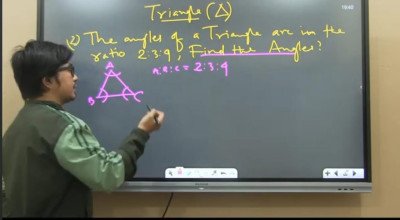Course description
In a class 11 curriculum, the study of conic sections typically involves a detailed examination of the properties, equations, and geometric representations of four fundamental types of curves: the circle, ellipse, parabola, and hyperbola. Here's an overview:
1. Introduction to Conic Sections:
Conic sections are curves formed by the intersection of a plane with a double-napped cone. The types of conic sections depend on the angle and position of the intersecting plane relative to the cone.
2. The Circle:
Define the circle as the locus of points equidistant from a fixed point called the center. Discuss the equation of a circle, its radius, and its geometric properties.
3. The Ellipse:
Introduce the ellipse as the locus of points such that the sum of the distances from two fixed points (the foci) is constant. Discuss the standard form equations of ellipses, eccentricity, major and minor axes, and geometric properties.
4. The Parabola:
Define the parabola as the locus of points equidistant from a fixed point (the focus) and a fixed line (the directrix). Discuss the standard form equations of parabolas, focus-directrix property, vertex, axis, and geometric properties.
5. The Hyperbola:
Introduce the hyperbola as the locus of points such that the absolute difference of the distances from two fixed points (the foci) is constant. Discuss the standard form equations of hyperbolas, eccentricity, transverse and conjugate axes, asymptotes, and geometric properties.
6. Conic Sections in Cartesian Coordinates:
Discuss how conic sections can be represented algebraically in Cartesian coordinates by quadratic equations.
7. Graphing Conic Sections:
Demonstrate how to graph conic sections by identifying key features such as the center, foci, vertices, asymptotes, and axes.
ক্লাস 11 পাঠ্যক্রমে, কনিক বিভাগগুলির অধ্যয়নে সাধারণত চারটি মৌলিক ধরণের বক্ররেখার বৈশিষ্ট্য, সমীকরণ এবং জ্যামিতিক উপস্থাপনাগুলির একটি বিশদ পরীক্ষা জড়িত: বৃত্ত, উপবৃত্ত, প্যারাবোলা এবং হাইপারবোলা। এখানে একটি ওভারভিউ:
1. কনিক বিভাগগুলির ভূমিকা:
কনিক বিভাগগুলি একটি ডবল-নেপড শঙ্কু সহ একটি সমতলের ছেদ দ্বারা গঠিত বক্ররেখা। শঙ্কু বিভাগগুলির ধরনগুলি শঙ্কুর সাপেক্ষে ছেদকারী সমতলের কোণ এবং অবস্থানের উপর নির্ভর করে।
2. বৃত্ত:
কেন্দ্র নামক একটি নির্দিষ্ট বিন্দু থেকে সমান দূরত্বের বিন্দুগুলির অবস্থান হিসাবে বৃত্তটিকে সংজ্ঞায়িত করুন। একটি বৃত্তের সমীকরণ, এর ব্যাসার্ধ এবং এর জ্যামিতিক বৈশিষ্ট্য আলোচনা কর।
3. উপবৃত্ত:
উপবৃত্তটিকে বিন্দুর অবস্থান হিসাবে উপস্থাপন করুন যাতে দুটি স্থির বিন্দু (ফোসি) থেকে দূরত্বের যোগফল ধ্রুবক থাকে। উপবৃত্ত, বিকেন্দ্রিকতা, প্রধান এবং ছোট অক্ষ এবং জ্যামিতিক বৈশিষ্ট্যের আদর্শ ফর্ম সমীকরণ আলোচনা কর।
4. প্যারাবোলা:
একটি নির্দিষ্ট বিন্দু (ফোকাস) এবং একটি স্থির রেখা (ডাইরেক্ট্রিক্স) থেকে সমদূরবর্তী বিন্দুগুলির অবস্থান হিসাবে প্যারাবোলাকে সংজ্ঞায়িত করুন। প্যারাবোলা, ফোকাস-ডাইরেক্ট্রিক্স প্রপার্টি, শীর্ষবিন্দু, অক্ষ এবং জ্যামিতিক বৈশিষ্ট্যের আদর্শ ফর্ম সমীকরণ আলোচনা কর।
5. হাইপারবোলা:
হাইপারবোলাকে বিন্দুর অবস্থান হিসাবে উপস্থাপন করুন যাতে দুটি স্থির বিন্দু (ফোসি) থেকে দূরত্বের পরম পার্থক্য স্থির থাকে। হাইপারবোলাস, বিকেন্দ্রিকতা, ট্রান্সভার্স এবং কনজুগেট অক্ষ, অ্যাসিম্পটোটস এবং জ্যামিতিক বৈশিষ্ট্যগুলির মানক ফর্মের সমীকরণগুলি আলোচনা কর।
6. কার্টেসিয়ান স্থানাঙ্কে কনিক বিভাগ:
কার্টেসিয়ান স্থানাঙ্কে দ্বিঘাত সমীকরণের মাধ্যমে কীভাবে শঙ্কু বিভাগগুলি বীজগণিতভাবে উপস্থাপন করা যায় তা আলোচনা করুন।
7. গ্রাফিং কনিক বিভাগ:
কেন্দ্র, ফোসি, শীর্ষবিন্দু, অ্যাসিম্পটোটস এবং অক্ষের মতো মূল বৈশিষ্ট্যগুলি সনাক্ত করে কীভাবে কনিক বিভাগগুলিকে গ্রাফ করতে হয় তা প্রদর্শন করুন।



















